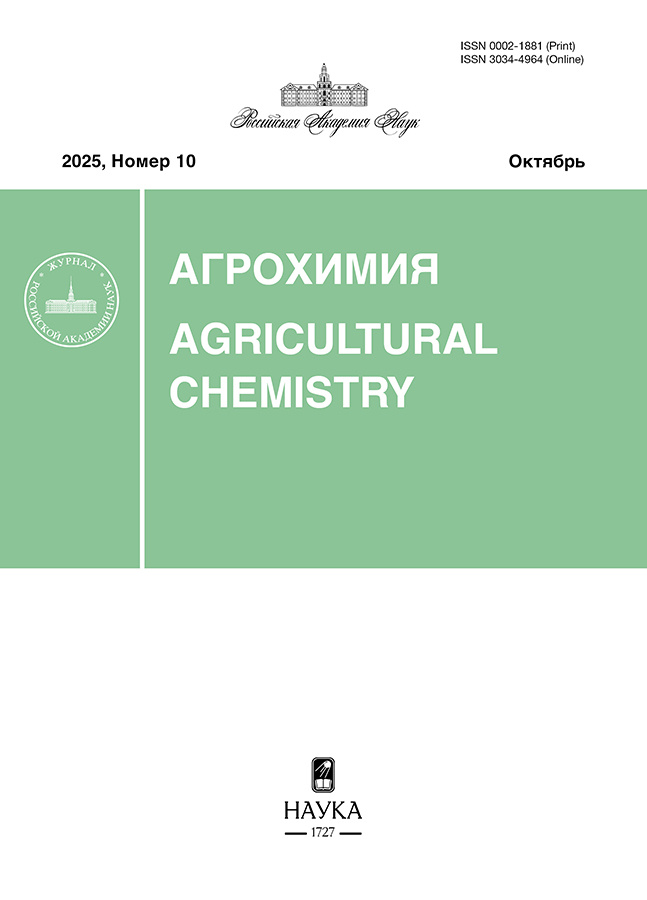Влияние длительного последействия известкования дерново-подзолистой почвы доломитовой мукой на микроэлементный состав растений ячменя
- Авторы: Витковская С.Е.1,2
-
Учреждения:
- Российский государственный гидрометеорологический университет
- Агрофизический научно-исследовательский институт
- Выпуск: № 9 (2024)
- Страницы: 43-50
- Раздел: Экспериментальные статьи
- URL: https://rjsvd.com/0002-1881/article/view/647206
- DOI: https://doi.org/10.31857/S0002188124090059
- EDN: https://elibrary.ru/CCTVSI
- ID: 647206
Цитировать
Полный текст
Аннотация
В многолетнем прецизионном микрополевом эксперименте изучено влияние известкования кислой дерново-подзолистой легкосуглинистой почвы доломитовой мукой (ДМ, диапазон доз 0–2.0 Нг, 9-й год последействия) на реакцию почвы, содержание подвижных соединений Zn, Cu, Mn, Fe, Cd, Pb в почве и микроэлементный состав растений ячменя (Hordeum L.). Выявлено, что наиболее чувствительными к изменению кислотно-основных свойств почвы были Zn и Mn, содержание которых в органах растений ячменя достоверно линейно уменьшалось в интервале доз ДМ 0–2.0 Нг. Существенным было последействие даже минимальной дозы ДМ (0.2 Нг). Наблюдали тенденцию к снижению содержания Fe в соломе и колосе растений (r = –0.572 и –0.570 соответственно) в указанном диапазоне доз. Полученные данные подтвердили, что известкование может приводить к увеличению содержания Cd в зерновых культурах: в интервале доз ДМ 0.8–2.0 Нг увеличение содержания элемента в колосе по отношению к контрольному варианту опыта достигало 1.6–2.0 раза, а в соломе – линейно возрастало в интервале доз ДМ 0–1.0 Нг (r = 0.945). Содержание Cu и Pb в растениях ячменя слабо зависело от дозы известкового мелиоранта.
Полный текст
Об авторах
С. Е. Витковская
Российский государственный гидрометеорологический университет; Агрофизический научно-исследовательский институт
Автор, ответственный за переписку.
Email: s.vitkovskaya@mail.ru
Россия, 192007 Санкт-Петербург, ул. Воронежская, 79; 195220 Санкт-Петербург, Гражданский просп., 14
Список литературы
- Шильников И.А., Сычёв В.Г., Зеленов Н.А., Аканова Н.И., Федотова Л.С. Известкование как фактор урожайности и почвенного плодородия. М.: ВНИИА, 2008. 340 с.
- Булатова Н.В., Чеботарёв Н.Т., Регорчук Н.В. Влияние длительного последействия извести и внесения минеральных удобрений на кислотно-основные свойства дерново-подзолистой почвы и продуктивность многолетних трав // Перм. аграрн. вестн. 2018. № 3(23). С. 35–41.
- Витковская С.Е., Яковлев О.Н., Шаврина К.Ф. Влияние возрастающих доз доломитовой муки на кислотно-основные свойства дерново-подзолис- той почвы // Агрохимия. 2016. № 7. С. 3–11.
- Витковская С.Е. Методы оценки эффективности и экологической безопасности химических мелиорантов. СПб.: АФИ, 2017. 76 с.
- Тармаева И.Ю., Боева А.В. Минеральные вещества, витамины: их роль в организме. Проблемы микронутриентой недостаточности: учеб. пособ. Иркутск: ИГМУ, 2014. 89 с.
- Самофалова И.А. Химический состав почв и почвообразующих пород: учеб. пособ. Пермь: Перм. ГСХА, 2009. 30 с.
- Витковская С.Е., Шаврина К.Ф., Яковлев О.Н. Продуктивность растений ячменя и взаимодействие цинка, кальция и магния в системе почва–растение при нейтрализации почвенной кислотности доломитовой мукой // Агрохимия. 2020. № 1. С. 50–57.
- Витковская С.Е., Шаврина К.Ф. Влияние известкования дерново-подзолистой легкосуглинистой почвы доломитовой мукой на урожайность сельскохозяйственных культур (результаты многолетнего микрополевого эксперимента) // Агрохимия. 2022. № 4. С. 52–59.
- Витковская С.Е., Яковлев О.Н., Оглуздин А.С., Дубовицкая В.И. Влияние возрастающих доз доломитовой муки на поведение тяжелых металлов в системе почва–растение // Пробл. агрохим. и экол. 2014. № 3. С. 31–34.
- Витковская С.Е., Яковлев О.Н. Влияние возрастающих доз доломитовой муки на распределение марганца и железа в системе почва–растение // Агрохимия. 2017. № 11. С. 44–51.
- Шаврина К.Ф., Витковская С.Е. Влияние возрастающих доз доломитовой муки на распределение цинка, кальция и магния в растениях овощных бобов // Мат-лы IV Международ. научн.-практ. конф. молод. ученых “Актуальные вопросы наук о Земле в концепции устойчивого развития Беларуси и сопредельных государств”. Ч. 2. Гомель, 2018. С. 151–154.
- Возбуцкая А.Е. Химия почвы / Под ред. Д.Л. Аскинази. 3-е изд. испр. и доп. М.: Высш. шк., 1968. 426 с.
- Кабата-Пендиас А., Пендиас X. Микроэлементы в почвах и растениях: Пер. с англ. М.: Мир, 1989. 439 с.
- Витковская С.Е., Шаврина К.Ф. Влияние различных доз органических и минеральных удобрений на распределение цинка в системе “дерново-подзолистая почва–растения озимой ржи” // Агрофизика. 2017. № 3. С. 4–12.
- Радыш И.В., Скальный А.В., Нотова С.В., Маршинская О.В., Казакова Т.В. Введение в элементологию: учеб. пособ. Оренбург: ОГУ, 2017. 183 с.
- Бурдуковский М.Л. Влияние длительной химизации почв юга Дальнего Востока на биологический круговорот и содержание макро- и микроэлементов: Дис. … канд. биол. наук. Владивосток, 2014. 134 с.
- Гальченко А.В., Назарова А.М. Эссенциальные микро- и ультрамикроэлементы в питании вегетарианцев и веганов. Ч. 1. Железо, цинк, медь, марганец // Микроэл-ты в медицине. 2019. Т. 20(4). С. 14–23.
- Методические указания по проведению комплексного мониторинга плодородия почв земель сельскохозяйственного назначения. М.: Росинформагротех, 2003. 240 с.
- Оберлис Д., Харланд Б., Скальный А. Биологическая роль макро- и микроэлементов у человека и животных / Под ред. А.В. Скального. Пер. с англ. Оренбург, 2018. 658 с.
- Каплин В.Г. Основы экотоксикологии. М.: КолосС, 2006. 232 с.
- Исидоров В.А. Введение в химическую экотоксикологию. Учеб. пособ. СПб.: Химиздат, 1999. 144 с.
- Кожина Л.Ф. Металлы подгруппы цинка и их соединения. Учеб.-метод. пособ. для студентов направления подготовки “Педагог. образ-е”, профиль “Химия”. Саратов, 2018. 49 с.
- Алексеев Ю.В. Тяжелые металлы в агроландшафте. СПб.: ПИЯФ РАН, 2008. 216 с.
- Алексеев Ю.В., Литвинович А.В., Маслова А.И. Экологическая проблема, возникающая при известковании почв в зерновых севооборотах // Продукционный процесс растений: теория и практика эффективного и ресурсосберегающего управления. Тр. Всерос. конф. с международ. участием. СПб.: АФИ, 2009. С. 207–211.
- Литвинович А.В., Ковлева А.О., Хомяков Ю.В., Лаврищев А.В., Павлова О.Ю. Возможность загрязнения кадмием яровых зерновых культур при мелиорации кислых почв // Агрохимия. 2014. № 4. С. 80–87.
- Титов А.Ф., Казнина Н.М., Таланова В.В. Устойчивость растений к кадмию (на примере семейства злаков): учеб. пособ. Петрозаводск: Карел. НЦ РАН, 2012. 55 с.
- Временный максимально-допустимый уровень (МДУ) содержания некоторых химических элементов и госсипола в кормах для сельскохозяйственных животных и кормовых добавках. М., 1987. 4 с.
- Ильин В.Б. Тяжелые металлы в системе почва–растение. Новосибирск: Наука, 1991. 151 с.
Дополнительные файлы












